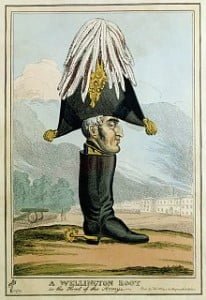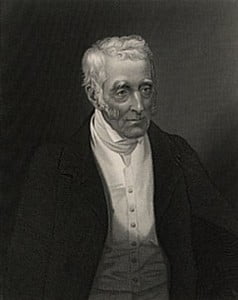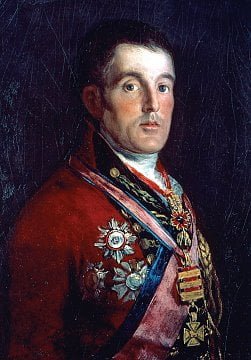The eventful life of Arthur, Duke of Wellington, was evenly apportioned between a triumphant military career and an equally successful political one.
His early involvement in both fields kept him away from home, which may explain why, notwithstanding his five-year membership of the Lodge in Trim, he never progressed beyond the first degree of Freemasonry.
Arthur Wesley, whose original 12th century name Wellesley was reverted to by the family in 1798, was almost certainly born in Dublin and not Trim, Co Meath, and almost certainly, on 1 May 1769 and not 29 March as has been claimed.
Wellingtons was the third of the five sons born to Garret Wesley III and Anne Hill. Every single one of the Wesley children was to excel in his own field of endeavour, and Arthur, amongst them, scintillated through a dazzling lifelong career. His early education in Trim, later in London, and from 1781 to 1784 at Eton College culminated, after an additional two years of private tuition, in his joining the prestigious Royal Academy of Equitation at Angers in Anjou, France. Through the influence of his elder Brother Richard, he was launched on a military career from the start.
He returned to Ireland in February 1788 and was appointed aide-de-camp to the Lord Lieutenant, and simultaneously followed in the political footsteps of the family. A Wesley had had a presence in the Irish Parliament since its inception as an independent Assembly in 1782. In April 1790 Arthur was elected MP for Trim, Ireland, aged 21.

His was initiated into the family Lodge, Trim No. 494, on 7 December the same year. Both his father and his brother served as Masters, and they both became Grand Masters of the Grand Lodge of Ireland.
Garrett Wellesley, first Earl of Mornington, was proposed as a member of the Lodge by one of its founders, John Boulger, and was raised a Master Mason in July 1775.
A year later he served as Master of the Lodge and was elected Grand Master of the Grand Lodge of Ireland, serving for one year, as was customary at the time, being succeeded by the Duke of Leinster in 1776. His eldest son, Richard, third Baron and second Earl of Mornington, was raised on 31 July 1781, having paid his late father’s arrears and his own admission fee a few weeks earlier. A year later he followed in the footsteps of the Rt. Hon. William Randall, Earl of Antrim (who also served as Grand Master of the Antients Grand Lodge of England) as the new Grand Master of Ireland.
Wellington would no doubt have followed in their footsteps had time permitted him to pursue his Masonic career. There is no reason to suppose that the young Arthur was in anyway disenchanted with the Craft. The Lodge records show that on 7 December 1790 he paid his admittance fee of £2 5s 6d.
He is here referred to as ‘the Honorable Capt. Wesley’. A second entry, on 26 June 1792, states: ‘Pd now in advance Br. Wesley 14s 1d’. The records continue to show several occasions on which his dues are paid, the last entry on 8 September 1795.
A further telling entry of his continued, even active, interest in Lodge affairs is his part purchase of an English Lottery Ticket on 16 February 1795 from the Lodge treasurer.
The minutes for that date show that two English lottery tickets, the property of the only remaining seven regular Brethren of the Lodge, cost £45 10s 0d and:
…the members who subscribed and are entitled to benefit of the tickets purchased of part of their fifty pounds are…the Honorable A. Wesley…
The logical conclusion that Arthur had intentions to progress in the Craft is supported by Lord Combermere, Provincial Grand Master of Cheshire, at the death of Wellington. On 31 December 1852 the Freemasons’ Quarterly Magazine and Review reported verbatim Lord Combermere’s words, addressed to the Brethren of the Province on 27 October that year:
Perhaps it is not generally known that he (the Duke of Wellington) was a mason; he was made in Ireland; and often when in Spain, where Masonry was prohibited, in conversation (with Lord Combermere), he regretted repeatedly how sorry he was his military duties had prevented him taking the active part his feelings dictated.
In June 1794 Wellington left Cork for Ostend in command of a brigade for his first taste of active service, and resigned from the Lodge when he was posted to Austria and then to India in 1796.
He returned to England in September 1805, and in April 1806 was elected MP for Rye in Sussex. He was later to represent Mitchell, Cornwall and Newport, Isle of Wight. A year later he joined the Duke of Portland’s Tory Government as Chief Secretary for Ireland.
Meanwhile, his military career was reaching a peak. In 1808 he was made a Lieutenant General and was involved in the various military campaigns against Napoleon, known as the Peninsular War.
Whilst stationed in Portugal in the autumn of 1809, an interesting episode provides an insight into his attitude toward Freemasonry. The Portuguese government, no doubt still under the influence of the several catholic Papal Bulls banning Freemasonry, had a natural political and religious distrust of Freemasons and other liberal bodies considered to be anti-clericals.

Freemasonry prospered in Portugal, not least since several of Napoleon’s officers were active in the Craft, including Marshals Lannes, Junot, and Ney.
Troops under Wellington held a Masonic meeting in Lisbon, following which they walked in procession and full regalia through the streets of the city. The Masons were stoned and only narrowly escaped being shot at, which was an embarrassment to the Duke, then acting as Marshal
General of the Portuguese Army. In an attempt to diffuse the tension, and in typical awareness of the sentiments of the local populace, Wellington issued a General Order dated 5 January 1810 addressed to his officers, requiring them to refrain from overt Masonic activity: an amusement which, however innocent in itself and allowed by the law of Great Britain, is a violation of the law of this [Portugal] Country, and very disagreeable to the people.
Five years later Wellington was again to come face to face with his Masonic reputation. Marshal Michel Ney, who met his end during the ‘White Terror’ as a traitor, executed by a firing squad on 7 December 1815 in a Paris public park, recognised Wellington as a Masonic brother.
In a document now apparently lost between Apsley House and the Southampton University archives, Marshal Ney appealed to Wellington ‘as a Brother’ to help save his life, but Wellington was not in a position to intervene.
A political cartoon called

the Head of the Armye
“A Wellington Boot – or the Head of the Armye”
Ney had been initiated in Le Trinosophes Lodge No. 494 in Paris under the Grand Orient of France in 1826, and a legend has persisted that the ‘Bravest of the Brave’, as he had been referred to by Napoleon, escaped execution with the help of French Freemasons and the Duke of Wellington.
The legend is perpetrated by the inscription on Peter Stuart Ney’s tomb in the Third Creek Presbyterian Church in rural Rowan County, North Carolina, USA:
In memory of Peter Stuart Ney, a native of France and soldier of the French Revolution under Napoleon Bonaparte, who departed this life Dec. 15, 1846, aged 77 years.
Peter Stuart Ney, a schoolmaster, was buried there in 1846. His last words on his deathbed are reported to have been:
By all that is holy, I am Marshal Ney of France.
Wellington’s military career was to reach its glorious peak on 18 June 1815 with the defeat of Napoleon at the Battle of Waterloo. He served as Commander-in-Chief of the Occupation forces until his return to England in November 1818, and within a month joined the Cabinet as Master- General of Ordnance. His political career was crowned with success when he became Prime Minister on 9 January 1828.
Much has been made of the Duke’s negative remarks about his initiation into Freemasonry. In 1838 when Lodge No. 494 of Trim decided to move to Dublin, the new secretary, Edward Carleton, wrote to the Duke asking for permission to rename the Lodge in his honour. The Duke’s reply was polite and firm:
…(the Duke) perfectly recollects he was admitted to the lowest grade of Free Masonry in a Lodge which was fixed at Trim, in the County of Meath. He has never since attended a Lodge of Free Masons. He cannot say that he knows anything of the Art. His consent to give this Lodge his Name would be a ridiculous assumption of the reputation of being attached to free Masonry; in addition to being a misrepresentation, The Duke of Wellington hopes, therefore, that Mr Carleton will excuse the Duke for declining to comply with his suggestion…

the Duke of Wellington
But the Lodge members did not to give up so easily. In March 1843 the secretary applied to the Grand Lodge of Ireland as follows:
To The Right Worshipful the Grand Lodge of Ireland
The Memorial of Lodge No. 494 formerly held in Trim but now in Dublin respectfully sheweth that on the seventh day of December 1790 His Grace The Duke of Wellington then the Honorable Capt. Wesley was admitted a member of said Lodge No. 494.
That his Grace the Duke of Wellington having since that period signalized himself in a manner universally known Lodge No. 494 therefore prays that if in your wisdom you shall find it not inexpedient you will permit said Lodge No. 494 to bear the name and title of The Wellington Lodge and your memorialists aim duty bound will pray
Dated Lodge Room 20 March 1843
James McDonnell Master
William Wilson SW
Frank Thorpe Porter JW
Richard Pim Secretary
The response is recorded in the Grand Lodge of Ireland Minutes of 6 April 1843:
Read a Memorial from Lodge 494 requesting permission to take the title of the Wellington Lodge. The Board recommend that said request be granted. Postponed for the reconsideration of Lodge 494
The 17 April 1843 minutes of Lodge 494 show their decision not to pursue the matter:
That this Lodge do communicate to the Grand Lodge their sense of the kind feeling they have received through the Secretary respecting the Memorial presented praying to be allowed in future to call themselves the Wellington Lodge and in consequence of the suggestions by him so expressed they beg to withdraw said memorial.
It may have been the reluctance by members of the Lodge to publicise these various communications that led to much confusion of the Duke’s membership of the Craft. These were added to following Wellington’s death on 14th September 1852.
In the Freemasons’ Quarterly magazine for 31 March 1854, a Mr Walsh sent in a letter dated 6 March, referring to the various fraternal tributes being paid to the memory of the late Duke of Wellington. Mr Walsh stated that he had been writing a book to be entitled Ancient Builders of the World and: I was anxious to have the name and date of reception into Freemasonry of every illustrious man…For this purpose, I wrote to the Duke of Wellington, and the following is his reply:
London October 13, 1851, F M The Duke of Wellington presents his compliments to Mr Walsh. He has received his letter of 7th ult. The Duke has no recollection of having been admitted a Freemason. He has no knowledge of that association.
Chetwood Crawley has correctly pointed out that the Duke of Wellington was now in his 82nd year, and that his blunt retort to an impertinent inquirer is much in character.

Credits and Bibliography:
Chetwood Crawley W J – Notes On Irish Freemasonry No VI, AQC LXV, 1902
Hayes, Rebecca – Librarian, Grand Lodge of Ireland, Dublin.
Longford, Elisabeth – Wellington, Abacus 2002.
Mainguy, Irene – Librarian, Grand Orient of France, Paris.
Slade, Sophie – Apsley House, The Wellington Museum, London.
Wellesley A R ed: Supplementary despatches and memoranda of Field Marshal Arthur Duke of Wellington, KG, London, 1858-72.
